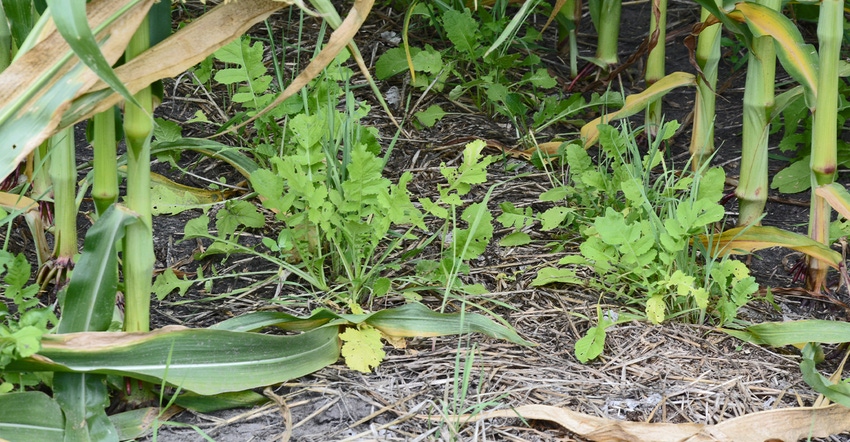June 11, 2019

Given the Upper Midwest’s challenges with establishing cover crops, University of Minnesota crop scientists took a look at interseeding them in corn at the five-leaf collar stage.
In a recent blog, Hannah Rusch, Jeff Coulter, Julie Grossman, Gregg Johnson, Paul Porter and Axel Garcia y Garcia reported on trials conducted in 2017 and 2018 where they broadcast-interseeded cover crops in corn at this stage in mid to late June at Grand Rapids, Lamberton and Waseca. They wanted to evaluate how interseeded cover crop monocultures and mixtures would establish and grow under a corn canopy and how the cover crop would affect corn yield.
They planted the following:
Two grass monocultures — annual ryegrass and cereal rye
Two mixtures of a grass and crimson clover
Two mixtures of a grass, crimson clover and a forage radish
Two no cover crop controls
They noted that cover crops were established before the corn canopy closed and persisted throughout the growing season. Corn grain was harvested, and the cover crops continued to grow until the onset of frost. Cover crop canopy cover and biomass were measured at fall frost and in the spring before cover crops were terminated with herbicide.
Cover crop establishment and growth
They saw cover crop canopy cover and biomass at fall frost vary by location, year and cover crop treatment.
Within a location, differences in canopy cover and biomass occurred among cover crop treatments in 2017. In 2018, however, differences occurred only at Grand Rapids. Across locations in both years, treatments with annual ryegrass had greater canopy cover in the fall than treatments with cereal rye.
Spring regrowth of cereal rye was minimal at all locations in 2018 and 2019, and no cereal rye regrew at Lamberton in 2019. When cover crops did regrow, canopy cover and biomass did not exceed 2.5% and 310-pound dry matter per acre, respectively, and there were no differences among cover crop treatments.
The researchers noted that the limited spring regrowth of cereal rye in this study contradicts the findings of most other studies from the Upper Midwest, which consistently show that cereal rye successfully overwinters and regrows in the spring when drilled in the fall after corn or soybean harvest. Compared to these studies, reduced spring regrowth of cereal rye in this study could be related to less seed-to-soil contact due to method of seeding (broadcasting versus drilling) and shading from corn.
Variation in cover crop establishment and regrowth in this study may be explained, in part, by weather conditions. In 2018, Lamberton and Waseca experienced abundant rainfall in the summer and fall, which led to ponding and subsequent loss of cover crops at both locations. Additionally, spring air temperatures in 2018 and 2019 were cool and late snowfall occurred in both years.
Corn yield
Corn grain yield was not affected by cover crops interseeded at the five-leaf collar stage at any location in both years. Across treatments and years, corn yield averaged 151 bushels per acre at Grand Rapids, 197 bushels per acre at Lamberton and 180 bushels per acre at Waseca. This suggests that environmental benefits of cover crops such as reduced nutrient losses and soil erosion may be obtained without a penalty to corn yield, they noted.
This study also highlights the potential of annual rye to be an equivalent or superior option to cereal ryegrass when interseeded alone or in a mixture with other cover crops at the five-leaf collar stage of corn. Research to further develop and optimize strategies for cover crop establishment to achieve agronomic and environmental benefits is ongoing.
Funding for the research was provided by the Minnesota Corn Research and Promotion Council.
Read the blog at bit.ly/interseedingincorn.
Source: University of Minnesota Extension, which is solely responsible for the information provided and is wholly owned by the source. Informa Business Media and all its subsidiaries are not responsible for any of the content contained in this information asset.
You May Also Like




